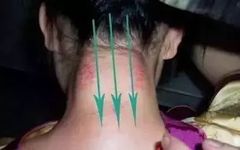The shoulder and neck area serves as a bridge connecting the head and torso, bearing the responsibility of communication between the blood vessels, nerves, and meridians of the head and the entire body. Therefore, the health of the shoulder and neck directly impacts the overall health of the body. By using Gua Sha to clear the meridians in the shoulder and neck area, not only can it treat ailments of the shoulder well, but it can also significantly improve facial conditions.
Gua Sha Techniques for the Shoulder and Neck
Choose a sitting or prone position, exposing the neck and shoulder area for scraping, and clean it with a warm towel.
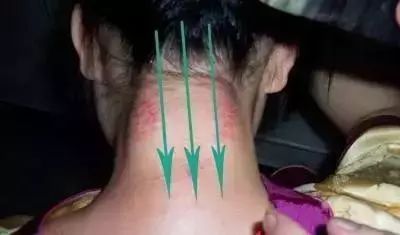
Neck Gua Sha
Sitting Position Gua Sha Method for the Neck:
First, apply a uniform layer of Gua Sha medium (Gua Sha oil) on the neck, and use the flat side of the Gua Sha board to rub the skin until a sensation of warmth is felt; the person receiving the treatment must relax.
Next, start Gua Sha from the center of the neck, using a water buffalo horn Gua Sha board, scraping from the Fengfu (Wind Mansion) point down to the Taodao (Pathway) point below the Dazhui (Great Vertebra); scrape down from the Tianzhu (Heavenly Pillar) points on both sides of the Yamen (Mute Gate) to the Fengmen (Wind Gate) point. The Gua Sha board should be held at a 45-degree angle, scraping evenly and consistently, gradually increasing from light to moderate pressure. Throughout the Gua Sha process, the board should exert a force that penetrates into the skin, with each scraping line being rubbed 15-30 times.
Finally, scrape from both sides of the Fengchi (Wind Pool) points to the Jianjing (Shoulder Well) point, using point pressure and kneading techniques on the Fengchi and Jianjing points. Use light pressure for Gua Sha on the neck, scraping 15-30 times.
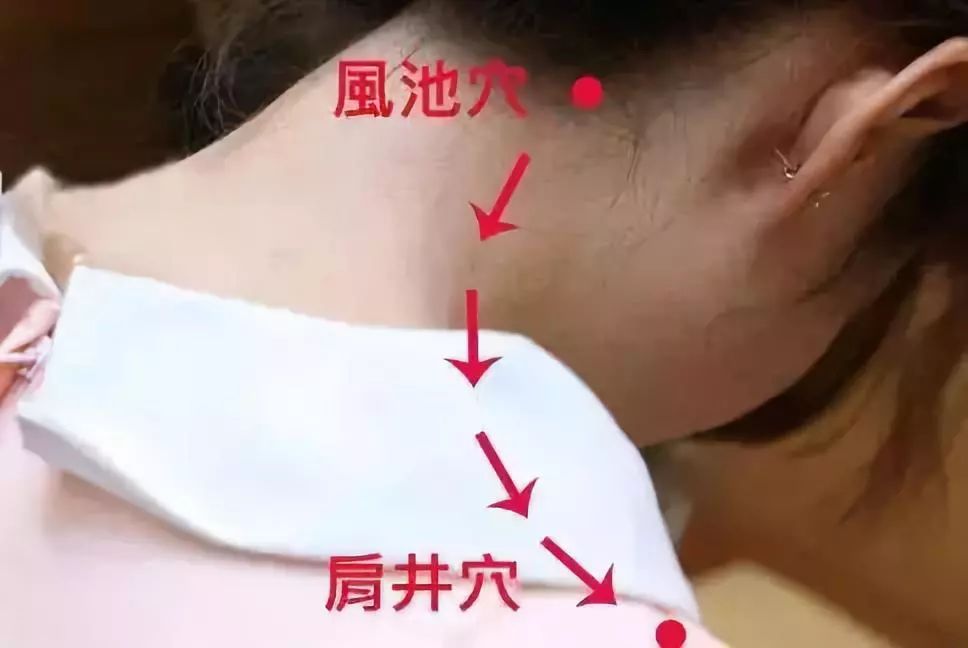
Shoulder Gua Sha
Prone Position Gua Sha for the Neck
Have the patient place their forehead in the recess of the bed, lying prone on the Gua Sha table, keeping the neck flexed to fully expose the skin of the neck and shoulders. The practitioner should sit directly in front of the patient.
Start scraping from the Fengfu (Wind Mansion) point at the center of the hairline towards the Taodao (Pathway) point at the first thoracic vertebra, then scrape down the Tianzhu (Heavenly Pillar) points on both sides to the Fengmen (Wind Gate) point, using light scraping techniques, with each area scraped 15-20 times.
Scrape from the concave areas on both sides of the hairline at the Fengchi (Wind Pool) points to the Jianjing (Shoulder Well) point in the center of the shoulders, scraping each side 15-20 times with light pressure, using point pressure and kneading techniques on the Fengchi and Jianjing points.
Specific Techniques for Back Gua Sha
Traditional Chinese Medicine (TCM) believes that the points along the Foot Taiyang Bladder Meridian on both sides of the spine are where the vital energy and blood of the internal organs are infused. Stimulating the back’s organ points has a direct regulatory effect on the essence and energy of the five internal organs. Modern medicine recognizes that the spine is not only the support of the human body but also the bridge connecting the spinal cord nerves to the brain, limbs, and internal organs. The nerve distribution of various body parts almost all originates from both sides of the spine. Based on the characteristics of nerve distribution and meridian points, Gua Sha can achieve the functions of clearing meridians, dispelling evil heat, and enhancing the body’s resistance. It can not only expel wind and release heat but also help regulate the overall function of the body.
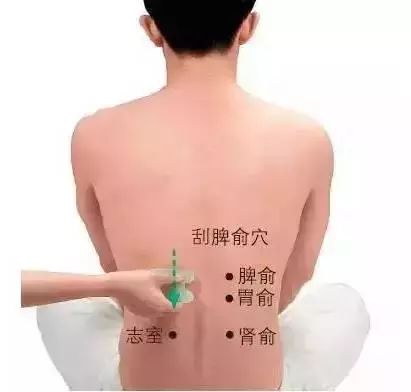
Back Gua Sha Diagram
Procedure is as follows
(1) First scrape the Du Meridian: Use one corner of a square Gua Sha board, tilting the board at a 45-degree angle to the skin, scraping from top to bottom (Dazhui to Sacrum), repeating each action 5-8 times until the Sha (bruising) appears.
(2) Use the corner of the Gua Sha board to scrape the meridians adjacent to the Du Meridian where the Huatuo Jiaji points are located.
(3) Use one corner of the square Gua Sha board to scrape along the scapular seams on both sides, keeping the board close to the skin with balanced pressure.
(4) Scrape the Bladder Meridian: first scrape the outer Bladder Meridian, then the inner Bladder Meridian. (The inner Bladder Meridian is located 1.5 inches away from the spine on both sides, while the outer Bladder Meridian is located 3 inches away from the spine on both sides.)
(5) Scrape diagonally down the rib seams: scrape five to six rib seams (do not scrape directly on the ribs), starting from the Du Meridian and scraping down to the ribs.
Each scraping area should not pursue excessive Sha; it is sufficient for the hair follicles in the scraped area to open. During the Gua Sha process on the back, since the back is a large reflex area of the body, bruises may appear in the areas scraped, indicating potential issues with corresponding organ functions or meridians.
Chest Gua Sha Techniques
Gua Sha can treat many diseases, promoting blood circulation and resolving stasis, but the techniques for Gua Sha vary depending on the specific body part. Many people in daily life are accustomed to only scraping the back, which can lead to an imbalance of Yin and Yang in the body over time. Therefore, while supplementing Yang, it is also necessary to scrape the chest and abdomen to replenish Yin.
Chest Gua Sha Method
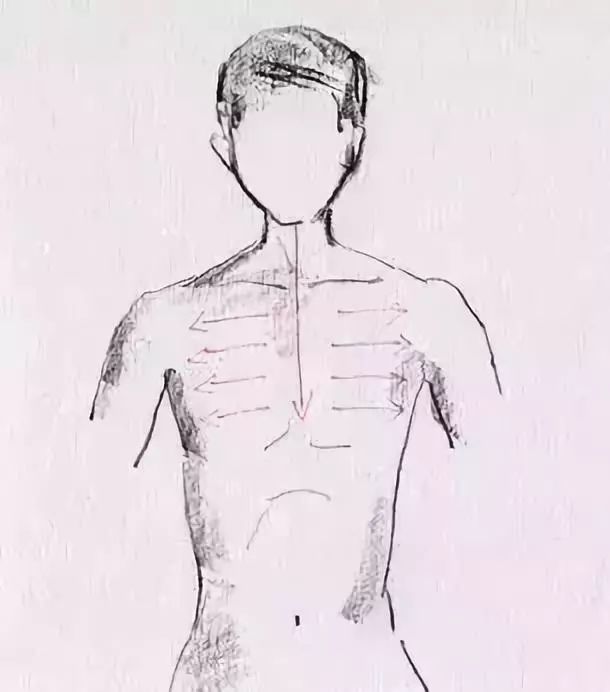
Chest Gua Sha
The order of operations for chest Gua Sha is to first scrape the Ren Meridian (the center), scraping all the way down to the lowest part of the sternum using a single-foot scraping method; then avoid the nipples and scrape horizontally on both sides.
When performing chest Gua Sha, the angle of contact between the scraping board and the body surface should be small, resulting in relatively less force; an angle of 45° is preferable, and the pressure should be light. The patient should be in a supine position, and the practitioner should be positioned on either side of the patient to begin.
(1) The practitioner applies a small amount of medium to the surface of the patient’s sternum, holding the Gua Sha board in the right hand, scraping from top to bottom along the Ren Meridian on the sternum, scraping a few more times at the Shanzhong (Middle of the Chest) point to promote Qi, and stopping at the Shangwan (Upper Stomach) point, achieving local Sha.
(2) Use the corner of the scraping board to gently press and knead the Tiantu (Heavenly Prominence) point (when pressing the Tiantu point, use light pressure as this area is deep and contains the trachea; excessive force may cause coughing or even choking).
(3) Using the sternum as the midline, the practitioner scrapes horizontally to the left and right along the ribs, ensuring the scraping board is in close contact with the ribs, maintaining a small angle. When passing over the nipples (not recommended for nursing women), the scraping should be avoided, and the scraping should continue until the local skin is slightly red.
Note: During chest Gua Sha, the angle of contact between the scraping board and the body surface should not be too large; the larger the angle, the greater the force applied. The chest houses the heart and lungs, and excessive force may impact and damage their functions, making it unsuitable for patients with severe heart or lung diseases.
Chest Gua Sha can not only improve conditions such as breast hyperplasia and poor blood circulation in the chest but also provide excellent effects for the treatment and preventive care of the heart, lungs, liver, gallbladder, spleen, and stomach.
Precautions for Chest Gua Sha
In addition to scraping vertically in the center, the rib area of the chest should be scraped horizontally (the chest is where the ribs are located; generally, Gua Sha is performed from top to bottom, but in the chest, only the center is scraped from top to bottom, while other areas are scraped horizontally. Although the meridians are vertical, scraping vertically would feel like rubbing on a washboard for thin individuals, which can be uncomfortable. Therefore, the rib areas of the chest should be scraped horizontally.
If the person is thin, the pressure should be light; if the scraping is too forceful or prolonged, it may cause damage to the periosteum.
When scraping horizontally, large areas should be scraped. The scraping board has a certain width, and the area of contact with the skin is the width of the board; do not use the corners to scrape along the rib grooves as this may cause rib damage.
The time spent scraping the rib area should not be too long. Generally, scraping should continue until the hair follicles are slightly open; excessive scraping may cause damage to the periosteum.
Do not scrape the nipple area.
Specific Methods for Scraping the Limbs
Gua Sha on the limbs can not only help in a general sense of “promoting meridian flow and activating collaterals” but can also target specific meridians for therapeutic purposes. Below are illustrated methods commonly used for promoting meridian flow in the limbs.

Arm Gua Sha Sequence Diagram
Step 1: Apply Gua Sha oil to the inner and outer sides of the limbs, starting with the upper limbs: scrape the inner side of the arms from top to bottom, passing through the Hand Taiyin Lung Meridian, Hand Jueyin Pericardium Meridian, and Hand Shaoyin Heart Meridian. Then scrape the outer side of the upper limbs from top to bottom, passing through the Hand Yangming Large Intestine Meridian, Hand Shaoyang Sanjiao Meridian, and Hand Taiyang Small Intestine Meridian.
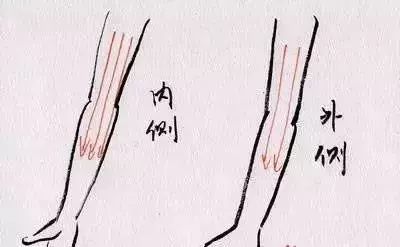
Leg Gua Sha Diagram
Step 2: For the lower limbs, start by scraping the knee points: first, use the corner of the scraping board to press the knee points from the inside out, pressing deeply first, then scraping outward. Then scrape the back of the knee joint, focusing on the Weizhong (Middle of the Weighing) point.
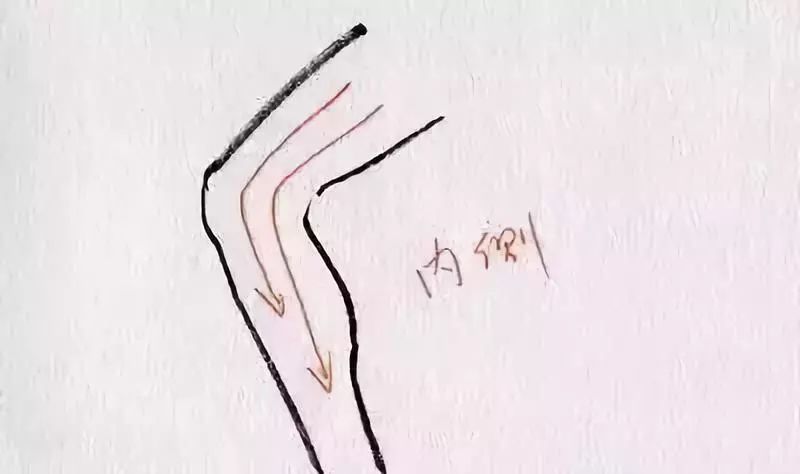
Inner Thigh Gua Sha Sequence Diagram
Step 3: Scrape the inner side of the lower limbs from top to bottom, passing through the Foot Taiyin Spleen Meridian, Foot Jueyin Liver Meridian, and Foot Shaoyin Kidney Meridian (focusing on key points such as Xuehai (Sea of Blood), Ququan (Spring at the Bend), Yinlingquan (Yin Mound Spring), Xiguan (Knee Gate), and Yingu (Yin Valley), etc.).
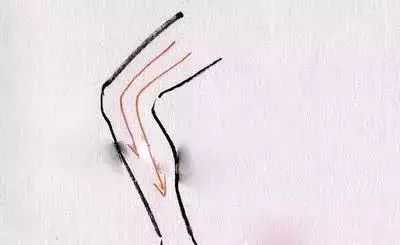
Outer Thigh Gua Sha Sequence Diagram
Step 4: Scrape the outer side of the lower limbs from top to bottom, passing through the Foot Yangming Stomach Meridian (Futu (Bunny), Liangqiu (Liang Hill), Dubi (Calf Nose)), Foot Shaoyang Gallbladder Meridian (Xiyangguan (Knee Yang Gate), Yanglingquan (Yang Mound Spring)), and Foot Taiyang Bladder Meridian (Yinmen (Yin Gate), Fuxie (Floating Vein), Weizhong (Middle of the Weighing), Weiyang (Weighing Yang), and Heyang (Joining Yang), etc.).
Precautions for Limb Gua Sha
1. The knee joint should be scraped using the corners of the Gua Sha board; special attention should be paid to those who are weak or have muscle atrophy.
2. When scraping the limbs, it is advisable to extend the scraping; avoid scraping over unclear lumps, infections, bone injuries, bruises, moles, or broken skin.
3. For patients with varicose veins or edema in the lower limbs, the scraping direction should be changed to upward from the bottom.
Recommended Articles with Over 100,000 Reads [Click on the Title to Read]
1. The “Anti-Inflammatory Point” of the Human Body is Located on the Hand!2. Moxibustion at this Point Can Expel the Most Deep-Seated Stasis, Cold Dampness, Phlegm, and Other Impurities! Making You Look 3-5 Years Younger!3. Too Many Acupoints to Remember? Just These Three Universal Points are Enough for Common Ailments!

